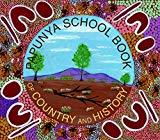
Title
Papunya School Book of Country and History
Author
Papunya School
Secondary Authors
Papunya School, Nadia Wheatley
Illustrators
Mary Malbunka, Punata Stockman
Publisher, Date
Allen & Unwin, 2001
Audience
5-8yrs, Lower Primary, Primary, Upper Primary
ISBN
186508526X
Language
English
Add to Favourites
-
Subjects
- Anangu people
- Arrernte / Aranda people (C8) (NT SG53-02)
- Children as artists
- Children as authors
- Country
- Glossaries and vocabularies
- History
- Human rights
- Luritja / Loritja people (C7.1) (NT SG52-04)
- Papunya (South Central NT SF52-16)
- Pintupi people (C10) (NT SF52-11)
- Reconciliation
- Warlpiri people (C15) (NT SF52-04)
-
Annotation
This important book describes the history of the Anangu (people of the central desert region of Australia) and how they came to live at Papunya. This book’s intention is ‘two way learning: Anangu way, and Western way.’ Its stunning pictures and layout tell the story of how traditional life changed for the many people and languages of this region when Tjulkura (white people) came.
Historian and multi-award-winning author Nadia Wheatley retells this history chronologically and with compassion, adopting the voices of the people who told it to her. The publisher has skilfully combined illustrations by Ken Searle with photographs, maps, and children’s art. This is a splendid picture book with many narratives – the colour coding of text boxes helps the reader to identify and differentiate the main story; timelines; and stories told by community members in their own voices. A beautiful fold out painted timeline and glossary end the book.
The early 1970s are acknowledged by art historians as 'a critical turning point when the ancient visual language of the Western Desert was rendered permanent on sheets of composition board and thereby transformed into a rich new art form: artefact became art.' The narrative ends with the idea that Papunya School could lead others in telling their story and sharing their culture: their legacy can be seen in other books published since 2001.
-
Teaching Resources
- Reading Australia Guide https://readingaustralia.com.au/books/papunya-school-book-of-country-and-history/
- Allen & Unwin Teachers Notes by Diane de Vere & Nadia Wheatley for “Papunya School Book of Country and History https://s3-ap-southeast-2.amazonaws.com/dimo.allenunwin.com/assets/teaching_resource/9781865085258.pdf
- More information about Papunya https://www.indigenous.gov.au/community/papunya-warrumpi
- Papunya's place in art history https://www.ngv.vic.gov.au/exhibition/tjukurrtjanu/
